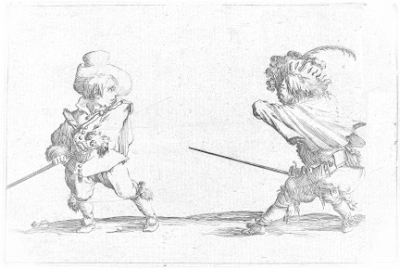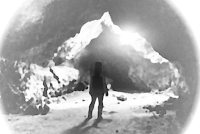He's not got treasure or anything; but he's in there.

|
|
Scale: 10 ft. Click here for a PDF version of this adventure! |
As I've mentioned in the past, I am prone to long swaths of descriptive text or purple prose. Writing dungeons for OSR consumption - then - becomes a challenge: to make a dungeon adventure more usable, more suitable to a home sandbox, it's a service to the product and to the reader to be terse: to provide few notes so that the referee has enough material to build on, but likewise ample room to expand, to flavor, and to fit the adventure into their setting and tone. This adventure - thus - is an exercise in brevity: it is a fully inclusive adventure, runnable on its own, but also one of my shortest PDFs - clocking in only 6 pages at font size 12 despite having 19 keyed rooms.
So - let me know what you think! Does this format work better, or do you prefer the more descriptive version - with set dressing peppered into the empty rooms?
Delve on, readers!
I) Stairs lead into the level in this room. They hover - supported by apparently nothing - and the underside of the stairs glow luminously - enough to light the space in a dim tone. If anything ferrous touches the glowing portion, it becomes magnetized: granting a +1 bonus to hit against armored opponents, but imposing a -1 penalty to hit if the wielder is wearing armor. On mundane equipment, the effect is permanent; magical equipment is affected only for 1d4 hours.
II) The secret door to the south has been discovered by 5 Goblins (B36), who are trying to pry it open.
III) A metal cage encloses a pedestal with a resplendent black orb. Inside, several dry-mummified bodies: all looking to have been geriatric when they died. If a character touches the metal cage - they must Save vs Spells or age 1d8 years. The door is locked.
The orb functions as Crystal Ball: but when looking underground or in a dark place, will function better - producing a clearer, more detailed picture - than in bright light: in which it will appear blurry.
IV) In the south of the room are two hives containing 7 Killer Bees (B37). In the one can be found 2 doses of the Killer Bees' curative honey; in the other can be found a satchel containing 200sp in addition to a further 500gp.
V) In the hall here is a pit trap, 10' wide by 10' long by 20' deep. Characters in the area of the trap if it activates must Save vs Paralysis or fall - taking 2d6 damage and stranding them at the bottom of the pit.
VI) In the center of this chamber, iron bars block half the hall - three times - in sequence, such that a character might have to zig-zag while walking to get around. Phantom bars block the other half of each - translucent and intangible, but visible. A character has no ill effect from walking through the phantom bars.
VII) Several Elf-like, but not Elf, figures are dancing, floating around a foot off the ground, as though in a ballroom. When the party enters, they will dissipate.
VIII) Hanging in the narrow, central to the room, is a massive nest containing 10 Killer Bees (B37). Inside the nest can be found 4 doses of their curative honey: likewise entombed in part of the nest - such that if it is opened or removed, the hive will be damaged - is a large wooden chest with iron straps. Inside the chest can be found 800 sp, 100 gp, two zircon stones worth 10 gp each, and an oval diamond worth 100 gp.
IX) Against the south wall of this space is a barred section protecting a pool, rippling despite the stillness of the room, and glowing slightly - as though back-lit underneath. If the party finds a way into the space and dips an item into the pool, it will glow like a torch for 2d4 turns. If a character immerses themselves in it, the character's skin will glow - as a candle: not enough to light the way - for 1d4 turns: but at the end of the adventure, the character will benefit from a 10% bonus to XP earned for the adventure. Immersing one character or immersing up to 1d6 items will cause the magic to fade, the slight glow of the pool going dark. The pool will refresh its magic at midnight of the next full moon.
X) Trapped in this room are 4 Normal Wolves (B44). A mostly-eaten beastmaster lies on the floor. His armor is ruined, his rations consumed, but he has some miscellaneous survival gear and a pouch containing 400 sp and 100 gp.
XI) A candelabra with no candles - rusted and heavy - hangs in this space. The candelabra is trapped. If a trigger plate is stepped on while traversing the room, the candelabra falls: roll to hit any character underneath - THAC0 14 - for 1d8 damage. The trap resets itself after one turn has passed.
XII) An idol head hangs from a pillar in the ceiling, suspended over the floor. It faces North. It will turn on a pivot freely and - if pointed to face either of the two secret doors, an audible unlocking noise can be heard. If either door is unlocked, it can be pushed inwards and will slide down. If either door is locked, it will not budge - appearing simply a section of wall. If one door is open, the idol cannot be turned to face away from it.
XIII) A lone Dwarf (B35) - dazed and bereft - is hiding in this space, their party having been defeated and themselves having fled. The door to the east is locked; the door to the west, the Dwarf has spiked shut.
XIV) In the center of the room is a stone circle, on which lie 700 silver pieces. Surrounding the stone circle, a concentric circular depression, roughly two inches deep, filled with a seemingly innocuous liquid. A character can walk through the liquid - no problem - however, the floors of this room, if a part of the character wet by the liquid comes into contact with them, will stick fast and can only be pulled loose on 1-in-6, modified by Strength. Additionally, when a character stands on the center circle, it will depress slightly. There is a cumulative chance - X-in-6, where X is the number of characters on the circle, that the circle falls through, sinking suddenly to a 10 foot depth, filling with the liquid and potentially drowning any character stuck to the circle by aforementioned contact with the glue liquid.
XV) A shrine has been tucked into the corner of this space. If a character touches the idol in the shrine, its eyes will flare and a path will illuminate on the walls leading to XII.
XVI) This room is separated from the hall by iron bars. The door to this space is locked. Along the south and east walls are tables - for surgery or for torture: it's not clear. On further investigation, a pouch containing 600 sp and 500 gp has been slipped into a sluice under a metal drain.
XVII) A clutch of 9 Kobolds (B37) have made a home in the northern section here. Among their possessions is a key to the door to room 16. There is a snare in the hallway leading to this area which will raise a bladed net - ensnaring one character within it. When the net triggers, roll to hit, THAC0 18, to deal 1d6 damage, of the netted character. Regardless of hit, that one target is ensnared. If an ensnared character breaks out of the net without assistance, they will take 1d6 damage.
XVIII) Chuckling in this dead end are 13 Halflings (B36). They have just entered the dungeon via the stairwell in room 20, seeking the Dwarf in room 13, and have followed the corridor to the dead end - the anti-climactic nature of which has struck them as funny.
XIX) Stairs lead into this room
from outside the level. The south wall to this space is comprised of iron
bars. The door to the east is locked; the door to the west is ajar. In the
center of the barred wall is a wrought iron face with pursed lips. The face is
trapped - it is sensitive to heat and a character drawing close enough to
inspect it may trigger a cloud of material to blow out of the face's lips.
Save vs Breath or be blinded for 1d4 hours. The mechanism is controlled by an
electrum modulation coil, accessible from underneath the mask. The coil is
work 90 gp.


























